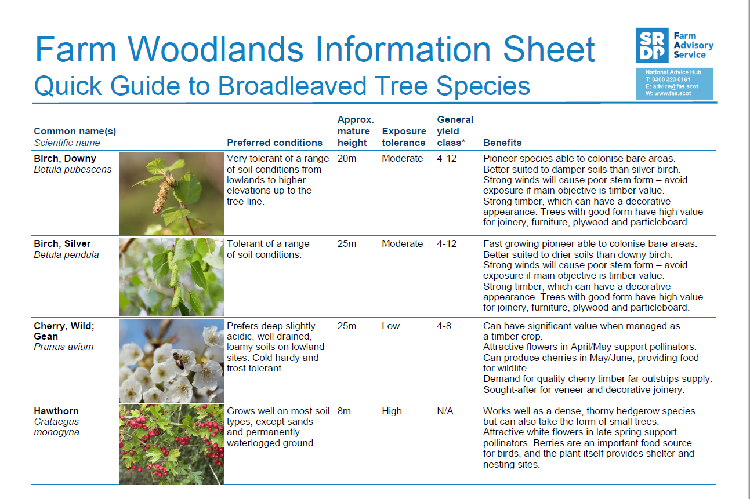Alder, Common;
Alnus glutinosa | 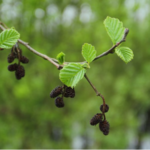 | Prefers deep, mainly acid soils. Suitable for land which is poorly drained, or prone to water-logging or flooding. Cold-hard and frost-resistant. | 25m | Low | 4-14 | Fixes nitrogen from the air and improves soil quality. Can improve growth of other tree species when grown in mixtures.
Good for riparian situations for sediment capture and bank stabilisation, and for reclamation sites.
Timber has value for wood turning.
Potential for coppicing. |
Aspen;
Populus tremula | 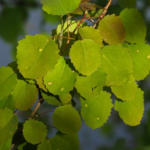 | Prefers moist/marshy clay soils, and next to watercourses.
Cold hardy and frost resistant. | 30m | Moderate | N/A | Fast growing, good at colonising poorer sites such as old quarries or gravel sites.
Ideal for riparian planting, along riversides or gullies. |
Beech;
Fagus sylvatica | 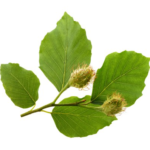 | Prefers reasonably deep fertile, well drained soil but will also grow in more acid conditions. | 30m | High | 4-10 | When trimmed or clipped to a hedge the trees usually hold their leaves through winter, providing increased shelter.
Straight-grained wood, that is easily worked and finishes well. Suitable for furniture, flooring and turnery.
Timber rotations typically 70-80 years. Beyond 100 years trees are likely to suffer rot and timber defects.
Not native. |
Birch, Downy;
Betula pubescens | 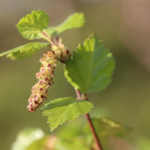 | Tolerant of a range of soil conditions. | 25m | Moderate | 4-12 | Fast growing pioneer able to colonise bare areas.
Better suited to drier soils than downy birch. Strong winds will cause poor stem form – avoid exposure if main objective is timber value.
Strong timber, which can have a decorative appearance. Trees with good form have high value for joinery, furniture, plywood and particleboard. |
Cherry, Wild;
Gean Prunus avium | 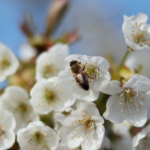 | Prefers deep slightly acidic, well drained, loamy soils on lowland sites. Cold hardy and frost tolerant. | 25m | Low | 4-8 | Can have significant value when managed as a timber crop.
Attractive flowers in April/May support pollinators. Can produce cherries in May/June, providing food for wildlife.
Demand for quality cherry timber far outstrips supply. Sought-after for veneer and decorative joinery. |
Hawthorn;
Crataegus monogyna | 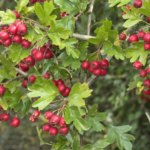 | Grows well on most soil types, except sands and permanently waterlogged ground. | 8m | High | N/A | Works well as a dense, thorny hedgerow species but can also take the form of small trees.
Attractive white flowers in late spring support pollinators. Berries are an important food source for birds, and the plant itself provides shelter and nesting sites. |
Hazel;
Corylus avellana | 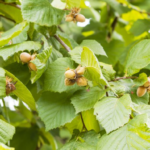 | Prefers fertile, deep, moist loamy soils although also capable of growing on heavy clay sites. | 6m | High | N/A | Usually a multi-stemmed shrub or small tree with potential for coppicing.
Can grow as understorey, increasing shelter provided by mature/ high canopy woods.
Good habitat for birds, including game birds.
Can produce hazelnuts in August/September, and is valuable for wildlife in woodlands and hedges. |
| Oak Pedunculate; Quercus robur | 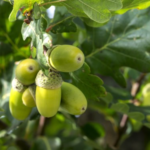 | Capable of growing on deep heavier, clay, acid soils. | 35m | Moderate | 4-8 | High ecological importance.
Can have high value if managed as a timber crop.
Potential for coppicing.
Strong, attractive, durable timber. Good quality oak can fetch a high price for furniture, joinery, panelling.
Grey squirrels must be controlled to avoid significant damage to timber quality. |
Oak, Sessile;
Quercus petraea | 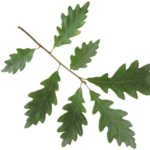 | Capable of growing on a range of soils but prefers drier, acidic, conditions with deep soil. | 35m | Moderate | 4-8 | High ecological importance.
Can have high value if managed as a timber crop.
Potential for coppicing.
Strong, attractive, durable timber. Good quality oak can fetch a high price for furniture, joinery, panelling.
Grey squirrels must be controlled to avoid significant damage to timber quality. |
| Rowan / mountain ash; Sorbus aucuparia | 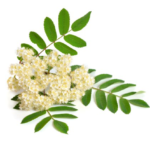 | Prefers moist, humus rich sites but is capable of growing in a range of habitats and higher elevations, right up to the tree-line. | 18m | High | N/A | Not sensitive to frost, very hardy.
High conservation value.
Attractive white blossom in May and red berries from September support pollinators and wildlife.
Fruit can be used to make preserves or jelly. |
Sycamore;
Acer pseudoplatanus | 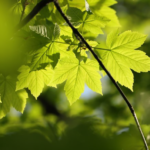 | Prefers deep, moderately fertile, alkaline, moist or damp conditions. | 35m | High | 4-12 | Can have high value if managed as a timber crop.
Potential for coppicing.
Hard, strong, stable timber. Suitable for furniture, joinery and flooring.
Grey squirrels must be controlled to avoid significant damage to timber quality.
Not native. |
Willow, Goat;
Salix caprea | 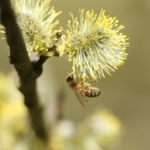 | Suitable for damp soils, mashes and wetter ground. | 10m | High | N/A | Fast growing.
Valuable for stabilising banks when planted in riparian areas.
Foliage has high nutritional value, with potential as supplementary livestock diet, and for cutting tree hay once established. |
